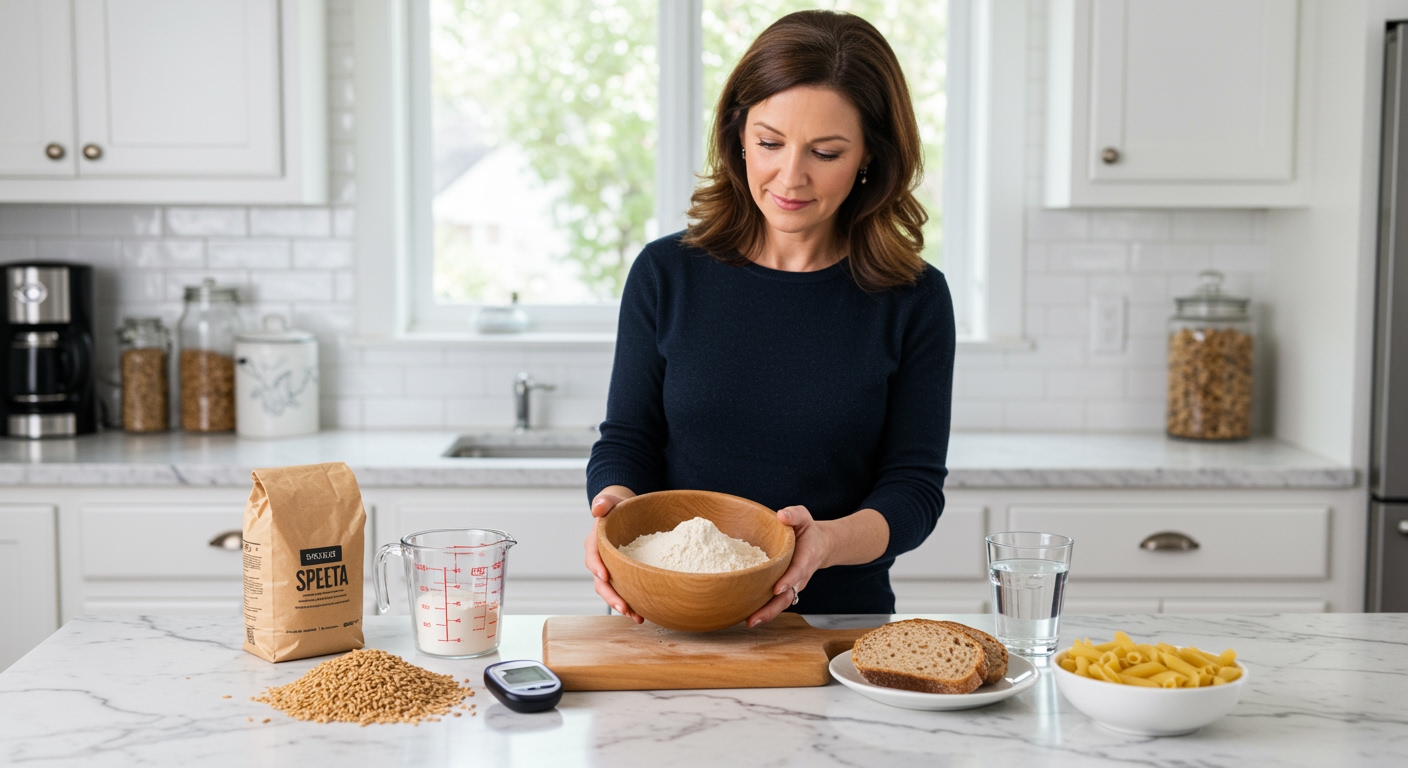✪ Key Takeaway: Spelt flour has a moderate glycemic index but still raises blood sugar significantly in people with diabetes.
Introduction
Your doctor just told you to watch your carbs and suddenly every flour aisle feels like a minefield.
You might be wondering if spelt flour could be your secret weapon against blood sugar spikes since everyone talks about ancient grains being healthier.
Hi, I’m Abdur, your nutrition coach and today I’m going to explain exactly how spelt flour affects your blood sugar and whether it belongs in your diabetes meal plan.
What Makes Spelt Flour Different From Regular Flour?
Spelt is an ancient wheat variety that people grew thousands of years before modern wheat took over our food system.
This grain contains more protein and fiber than regular wheat flour, which sounds promising for blood sugar control.
The protein content in spelt flour ranges from 14-18% compared to 10-12% in regular wheat flour.
Higher protein means your body digests spelt flour more slowly, which should theoretically create a gentler blood sugar rise.
Spelt also contains more minerals like magnesium and zinc, but these nutrients do not directly impact your glucose response.
The fiber content in spelt flour is about 2-3 grams higher per cup than regular wheat flour.
This extra fiber can slow down carbohydrate absorption in your small intestine, potentially reducing blood sugar spikes.
✪ Fact: Spelt contains gluten just like regular wheat, so it is not suitable for people with celiac disease.
How Does Spelt Flour Affect Your Blood Sugar?
The glycemic index of spelt flour ranges from 55-65, placing it in the moderate category rather than low.
This means spelt flour will still raise your blood sugar significantly, just not as quickly as white bread or regular wheat flour.
When you eat spelt flour products, your digestive system breaks down the starches into glucose molecules that enter your bloodstream.
The higher protein and fiber content does slow this process down compared to refined wheat flour.
However, spelt flour still contains about 70-75 grams of carbohydrates per cup, which is substantial for anyone managing diabetes.
Your pancreas will still need to produce significant amounts of insulin to handle the glucose load from spelt flour.
People with type 2 diabetes often have insulin resistance, meaning their cells do not respond well to insulin signals, making blood sugar control even more challenging with any flour-based foods.
✪ Pro Tip: Test your blood sugar 2 hours after eating spelt products to see your personal response.
Is Spelt Flour Better Than Other Flour Options?
Compared to white flour, spelt flour offers better nutritional value and slightly better blood sugar control.
White flour has a glycemic index of 70-85, making spelt flour a modest improvement for diabetes management.
Whole wheat flour performs similarly to spelt flour in terms of blood sugar impact, with both having moderate glycemic indexes.
However, almond flour or coconut flour would be much better choices for people with diabetes since they contain far fewer carbohydrates.
Almond flour contains only 6 grams of net carbs per cup compared to spelt flour’s 70+ grams.
The portion size becomes critical when using any grain-based flour, including spelt flour.
Even with its slightly better profile, eating large amounts of spelt flour products will still cause significant blood sugar elevation in people with diabetes.
✪ Note: Combining spelt flour with protein and healthy fats can help slow glucose absorption.
Should You Include Spelt Flour In Your Diabetes Diet?
Spelt flour can be part of a diabetes diet, but it requires careful portion control and strategic meal planning.
If you choose to use spelt flour, limit yourself to small amounts and always pair it with protein and fiber-rich foods.
A reasonable serving might be 1-2 tablespoons of spelt flour in a recipe that serves multiple people.
Consider using spelt flour as a partial replacement rather than a complete substitute in your favorite recipes.
Mix spelt flour with lower-carb alternatives like almond flour to reduce the overall carbohydrate content of your baked goods.
Always monitor your blood glucose levels when trying new foods, including spelt flour products, to understand your individual response.
Some people with diabetes may find they can tolerate small amounts of spelt flour without major blood sugar spikes, while others may need to avoid it completely.
✪ Pro Tip: Eat spelt flour products earlier in the day when your insulin sensitivity is typically higher.
The Bottom Line
Spelt flour is marginally better than white flour for diabetes management, but it still contains enough carbohydrates to significantly impact your blood sugar levels.
Better nutrition does not always mean better for diabetes – the total carbohydrate content matters most for blood glucose control.
I would love to hear about your experiences with different flours and how they affect your blood sugar – please share your thoughts and questions in the comments below.
References
At NutritionCrown, we use quality and credible sources to ensure our content is accurate and trustworthy. Below are the sources referenced in creating this article:
- PMC: Spelt wheat: An alternative for people intolerant to common wheat
- Healthline: What Is Spelt? Nutrition, Benefits, and Uses
- Glycemic Index Net: Spelt Cooked Glycemic Index
- Medical News Today: What are the health benefits of spelt?





